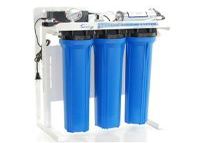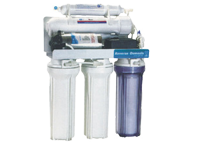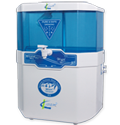

Water is a chemical compound with the chemical formula H 2O. A water molecule contains one oxygen and two hydrogen atoms that are connected by covalent bonds. Water is a liquid at standard ambient temperature and pressure, but it often co-exists on Earth with its solid state, ice, and gaseous state, steam (water vapor). Water covers 71% of the Earth's surface.

Rain is liquid water in the form of droplets that have condensed from atmospheric water vapor and then precipitated that is, become heavy enough to fall under gravity. Rain is a major component of the water cycle and is responsible for depositing most of the fresh water on the Earth.
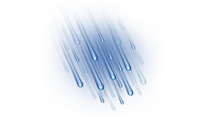
A water well is an excavation or structure created in the ground by digging, driving, boring, or drilling to access groundwater in underground aquifers. The well water is drawn by a pump, or using containers, such as buckets, that are raised mechanically or by hand. Wells can vary greatly in depth, water volume, and water quality. Well water typically contains more minerals in solution than surface water and may require treatment to soften the water.
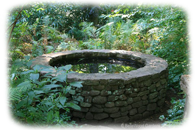
A river is a natural watercourse, usually freshwater, flowing towards an ocean, a lake, a sea, or another river. In a few cases, a river simply flows into the ground or dries up completely at the end of its course, and does not reach another body of water. Small rivers may be called by several other names, including stream, creek, brook, rivulet, and rill.

Drinking water is essential to humans and other lifeforms even though it provides no calories or organic nutrients. Water has always been an important and life-sustaining drink to humans and is essential to the survival of most other organisms. Excluding fat, water composes approximately 70% of the human body by mass. It is a crucial component of metabolic processes and serves as a solvent for many bodily solutes. Access to safe drinking water has improved over the last decades in almost every part of the world, but approximately one billion people still lack access to safe water and over 2.5 billion lack access to adequate sanitation.
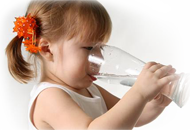
Waterborne diseases are caused by pathogenic microorganisms that most commonly are transmitted in contaminated fresh water. Infection commonly results during bathing, washing, drinking, in the preparation of food, or the consumption of food thus infected. Various forms of waterborne diarrheal disease probably are the most prominent examples, and affect mainly children in developing countries; according to the World Health Organization, such diseases account for an estimated 4.1% of the total DALY global burden of disease, and cause about 1.8 million human deaths annually. The World Health Organization estimates that 88% of that burden is attributable to unsafe water supply, sanitation and hygiene.
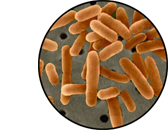
There are organic impurities, inorganic impurities and microbiological impurities. Organic impurities are caused due to suspended solids. Inorganic impurities are caused due to excess use of fertilizers in agricultural field. Human and factory waste water outlets (textile and tannery).
The quality of drinking water is deteriorating day by day. It is no longer as pure as it was during our forefather's time. Primary reasons why tapwater may no longer be safe for human consumption are:
Environmental & Climatic changes, draughts, spreading and uncontrolled industrialization has led to alarming levels of wastebeing disposed into our water sources such as rivers, water reservoirs and ground well water.

Due to ever increasing pollution levels, the water sources are under dire stress and are getting infected with dissolved impurities, bacteria & viruses.

With increased reliance on fungicides and insecticides in our agricultural industry, these harmful chemicals, when used excessively, seep into the ground well water as well as get washed away into the rivers.

Ageing pipeline network and poor maintenance results in municipal water getting infected by the time it reaches our homes.
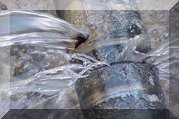
Since the demand for municipal water is greater than the supply and due to the onset of multi-storied buildings, the practice of storing water in overhead tanks has become more common.

Rivers are no longer sufficient to meet society's ever increasing demand of drinking water and hence there is an increased reliance on ground well water, which contains excessive levels of dissolved impurities making the water hard.

Filtration is commonly the mechanical or physical operation which is used for the separation of solids from liquids by interposing a medium through which only the fluid can pass. The fluid that pass through is called a filtrate. Oversize solids in the fluid are retained, but the separation is not complete; solids will be contaminated with some fluid and filtrate will contain fine particles (depending on the pore size and filter thickness).
It is an mechanical process we can replace the cartridges manually.
It is esy to handle
It cannot remove chemical toxins or microbiological impurities
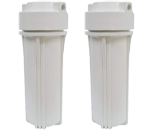
Boiling is the rapid vaporization of a liquid, which occurs when a liquid is heated to its boiling point, the temperature at which the vapor pressure of the liquid is equal to the pressure exerted on the liquid by the surrounding environmental pressure.
As a method of disinfecting water, bringing it to its boiling point at 100 °C (212 °F), is the oldest and most effective way since it does not affect the taste, is effective despite contaminants or particles present in it, and is a single step process which eliminates most microbes responsible for causing intestine related diseases. In places having a proper water purification system, it is only advocated as an emergency treatment method or for obtaining potable water in the wilderness or in rural areas.
It cannot remove chemical toxins or impurities.

Ultraviolet or "UV" is a type of energy found in the electromagnetic spectrum, lying between x-rays and visible light. Although we cannot see UV light or rays, we are exposed to them every time we step out into the sun. In fact, UV light is responsible for causing sunburns. Ultraviolet systems use special lamps or bulbs that emit UV light of a particular wavelength. The Ultraviolet energy attacks the genetic core of the microorganism and rearranges the DNA /RNA eliminating the microorganism's ability to function and reproduce. If the microorganism can no longer reproduce, it cannot replicate, therefore it cannot infect other organisms with which has contact. The process is simple but effective, destroying 99.99 percent of harmful microorganisms without adding chemicals to the water.

Reverse osmosis (RO) is a water purification technology that uses a semipermeable membrane. This membrane technology is not properly a filtration method. In reverse osmosis, an applied pressure is used to overcome osmotic pressure, a colligative property, that is driven by chemical potential, a thermodynamic parameter. Reverse osmosis can remove many types of molecules and ions from solutions, and is used in both industrial processes and producing potable water. The result is the solute is retained on the pressurized side of the membrane and the pure solvent is allowed to pass to the other side. To be "selective", this membrane should not allow large molecules or ions through the pores (holes), but should allow smaller components of the solution (such as the solvent) to pass freely.
In the normal osmosis process, the solvent naturally moves from an area of low solute concentration (high water potential), through a membrane, to an area of high solute concentration (low water potential). The movement of a pure solvent is driven to reduce the free energy of the system by equalizing solute concentrations on each side of a membrane, generating osmotic pressure. Applying an external pressure to reverse the natural flow of pure solvent, thus, is reverse osmosis. The process is similar to other membrane technology applications. However, key differences are found between reverse osmosis and filtration. The predominant removal mechanism in membrane filtration is straining, or size exclusion, so the process can theoretically achieve perfect exclusion of particles regardless of operational parameters such as influent pressure and concentration. Moreover, reverse osmosis involves a diffusive mechanism, so that separation efficiency is dependent on solute concentration, pressure, and water flux rate. Reverse osmosis is most commonly known for its use in drinking water purification from seawater, removing the salt and other effluent materials from the water molecules.
